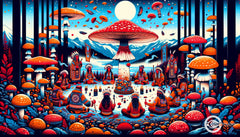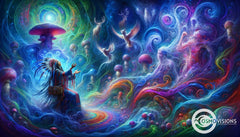The Fly-Agaric in the Americas: An Exploration of Indigenous Traditions
Posted by Massimiliano Geraci

The iconic red-and-white speckled mushroom known as Amanita muscaria, or fly-agaric, has a rich history of shamanic and spiritual use, particularly among the indigenous peoples of Siberia. The mind-altering properties of this mushroom are well-documented, with Siberian shamans using it as a gateway to mystical states and supernatural realms. However, the traditional usage of fly-agaric in the Americas is far less widely known.
Recent ethnographic research has uncovered fascinating clues about the indigenous traditions surrounding this mushroom among various Native American groups, from the northern reaches of Canada down through Mesoamerica. These findings reveal nuances in how certain peoples viewed the fly-agaric, hinting at a depth of spiritual meaning not unlike that found in Siberia.
At Cosmovisions, we seek to honor the spiritual heritage of diverse cultures worldwide through wearable art and high fashion. As such, exploring the shamanic dimensions of fly-agaric gives us insight into the visionary perspectives that shape humanity’s understanding of the mystical realms. Our hope is that by interweaving ancient symbols with contemporary style, we might play a small part in keeping ancestral wisdom alive.
North America
Early Accounts Among the Indigenous Peoples of Quebec
One of the earliest written accounts of fly-agaric use among North American indigenous peoples comes from a Jesuit missionary in 17th century Quebec. Father Charles L’Allemant, Superior of the Jesuit Mission in Canada, wrote a letter to his brother Jerome in France on August 1, 1626 describing some customs of the local natives. In it, he stated:
“They believe, as you see, in the immortality of our souls, and they assert in fact that after death, they go to Heaven where they eat mushrooms, and communicate with each other.”
The renowned ethnomycologist R. Gordon Wasson interpreted this passage as evidence that the native peoples of Quebec practiced fly-agaric shamanism. He even went so far as to definitively identify the “mushrooms” mentioned by L’Allemant as Amanita muscaria. However, while plausible, this conclusion rests on assumptions. As academics, we must refrain from simplistic or overconfident interpretations when analyzing historical texts through a modern lens.
Nonetheless, considering contemporary usage of fly-agaric mushrooms among native groups inhabiting the same region, this identification cannot be ruled out either. As we will see, modern ethnographic findings lend credence to the notion that Algonquian-speaking peoples have long held spiritual beliefs about mushrooms, particularly the red-capped Amanita muscaria.

Contemporary Usage Among the Ojibwe
The existence of a mushroom-focused spiritual tradition among the Ojibwe, also known as the Chippewa, has become increasingly clear thanks to modern ethnographic research. The Ojibwe inhabit a vast territory spanning from Ontario, Canada to Montana, United States, speaking Algonquian languages closely related to those of the indigenous peoples L’Allemant described in 17th century Quebec.
Legends Linking Mushrooms to the Land of the Dead
Ojibwe oral histories contain provocative mushroom motifs relating to lands inhabited by departed souls. An illustration of this theme appears in a published collection of Ojibwe legends compiled by the native artist Norval Morrisseau. Morrisseau came from the Ojibwe band near Lake Nipigon and practiced shamanism before becoming a famous painter later in life. In one tale, he tells of a mushroom feast for the dead:
“An Ojibway medicine-man once dreamed that he visited the far southern place to which the Indians go when they die. After arriving there he saw Indians who had died long ago having a great mushroom feast and he was offered some. But he refused. The Indian thought that if he ate the mushrooms he would not return in his human form or to the place where he was sleeping.”
This story bears striking similarity to Father L’Allemant’s 17th century account of mushrooms in the Quebec natives’ afterlife. Both suggest the Ojibwe perceived a link between fungi and realms inhabited by departed souls.
Shamanic Use of the “Red Cap” Mushroom
During the 1970s, R. Gordon Wasson learned of contemporary Amanita muscaria usage among the Ojibwe from a shaman woman named Keewaydinoquay. She revealed her tribe’s name for the fly-agaric mushroom was “miskwedo”, meaning “red cap.” Keewaydinoquay explained that she first consumed miskwedo mushrooms around age fourteen under the guidance of elders. She reported using it three to five times annually in her shamanic practice.
Wasson also recorded a legend passed down among the Ojibwe relating to miskwedo mushrooms. It shares intriguing parallels with old Siberian myths about fly-agaric’s origins and properties. As the story goes, a young boy unwittingly eats mushrooms that transform him into an elk. His grandmother then feeds the elk’s urine to the rest of the tribe, which causes them to experience the same visions. They subsequently honor the grandmother as the teacher of fly-agaric’s magical and spiritual powers.
Elements of this tale resemble recurring fly-agaric motifs in Siberian folklore—namely the notion that urine from those who ingest it contains vision-inducing properties. The elk transformation also hints at broader shamanic themes relating the mushroom’s abilities to metamorphose human consciousness.
The Story of the Miskwedo Passed Down in Ojibwe Oral Tradition
A second version of the miskwedo legend uncovered by scholar Eric Navet further demonstrates the continuity of these mushroom traditions. According to Navet’s brief summary, the Ojibwe painter Norval Morrisseau verified that elders still recount analogous versions of the story emphasizing fly-agaric’s transformative and visionary effects for shamans.
The cumulative evidence clearly indicates Amanita muscaria holds a substantial place in Ojibwe cultural and spiritual heritage. And in light of early missionary testimonies from Quebec, these shamanic customs almost certainly predate European contact. The fly-agaric appears to be no ordinary plant for North America’s Alqonquian-language speakers, who preserved sacred ancestral knowledge about its otherworldly powers.
Mesoamerica
Journeying farther south into Mesoamerica, we discover more subtle glimpses into the spiritual significance of the fly-agaric mushroom among other native peoples. The Maya in particular preserved mosaic fragments of ancestral wisdom hinting at ancient shamanic customs that modern minds struggle to fully piece together. But through an imaginative lens like that celebrated by Cosmovisions, we catch traces of divine magic underlying their eclectic mushroom traditions.
Diverse Perspectives Among the Maya of Mexico and Guatemala
Unlike Siberia’s unambiguous shamanic fly-agaric rituals, Maya groups held multifaceted views that resist straightforward interpretation. Some deemed the mushroom too poisonous for consumption, yet recognized its vision-inducing properties. Others made cryptic symbolic connections evoking lightning, death, and the sacred realms. Untangling these enigmatic threads requires acknowledging the nuances of indigenous cosmic perspectives.
View of Amanita Muscaria as Poisonous Yet Intoxicating
When interviewed by ethnobotanists, present-day Maya informants describe fly-agaric mushrooms using terms like “inebriating” or “toxic”. However, these labels merely reflect outsider terminology inadequately capturing indigenous cosmovision. The Popol Vuh, the Maya’s epiccreation narrative, depicts the primordial world as fluid, polymorphic, and characterized by material paradoxes transcending ordinary dualities.
So categories separating “poisons” from “remedies”, or “toxins” from “sacraments” likely misrepresent Maya interpretations of ethnogenic substances like the fly-agaric. More important is discerning the hidden connections they perceived betweenVisionary plants, celestial realms, and numinous forces underlying creation. Only then might we grasp vestiges of ancestral Perspectives on the mushrooms’ mythopoetic identity.
Term “Mushroom of the Lightning” Among the Tzotzil Maya
The fly-agaric’s celestial associations surface unambiguously among the Tzotzil Maya, who call it “yuy chauk” translating to “mushroom lightning”. Expressions like these resonate with Cosmovisions’ apparel depicting shamans morphing into thunderbirds. And echoes of storm deities linked to fungal epiphanies reverberate from Siberia’s mushroom customs to their diffusion along prehistoric Eurasian trade networks.
But deciphering the Maya’s syncretic religious symbology requires avoiding overly reductive Vedic parallels while still remaining open to transoceanic ethnomycological echoes. This nuanced hermeneutic approach reveals hints of a profound philosophy still glimmering from ancient Maya spiritual consciousness.

Analysis of Possible Mushroom Symbolism in the Popol Vuh
The enigmatic appearances of divine messengers named “Caculha” in the Maya’s Popol Vuh creation story present another perspective puzzle. Certain passages depict these caculha as lightning bolts acting as emissaries for celestial deities. However famed ethnobotanist R. Gordon Wasson conjectured that one caculha represented the vision-inducing fly-agaric mushroom known as “kaqulja” among contemporary Guatemalan Maya.
But singular identifications overlook the multidimensionality of Maya religious symbology. Like Cosmovisions apparel, hierophanic patterns weave symbolic strands into complex metaphorical textures resisting literal readings. The visionary world of Ancient Mesoamerica almost certainly incorporated indicators modern minds classify as either “mycological” or “meteorological”. But bifurcating organic/inorganic phenomena contradicts their seamless sacred interrelatedness within indigenous cosmovision.
So rather than decisively deciphering specific symbols, we enter imaginative realms by ruminating on their numinous implications. The caculha may simultaneously personify both storms and mushrooms linked through supernatural potencies. Their common ground is inducing divine visions revealing humanity’s paradoxical oneness with ecology’s abyssal mysteries.
Our brief excursion shows even surface traces of Mesoamerican fly-agaric customs offer gateways into lost spiritual dimensions. And like Indigenous shamans spanning millennia, Cosmovisions apparel invokes those realms’ magical power through artistic symbolism. For beneath the Maya’s rich symbolic tapestry lie intimations of a profound myco-spiritual heritage still nurturing mythic ways of being.
The Enduring Magic of the Fly-Agaric Across Earth’s Myco-Spiritual Tapestry
This exploration reveals remarkable continuity between fly-agaric’s shamanic usage among indigenous peoples of the Americas and spiritual customs spanning Eurasia. Despite fractures from cultural loss and migration, resilient fungal threads still stretch across oceans and epochs, interweaving three major realms:
First, fly-agaric signifies broad ethnomycological continuities binding psychoactive mushrooms traditions tracing back to Siberia across the Arctic to Subarctic and Eastern North America. Linguistic, genetic and mythic patterns attest to ancient waves of shamanic diffusion despite modern disruptions.
Second, uncanny myco-spiritual resonances echo between polysynthetic indigenous linguistic symbology and styles celebrated by Cosmovisions. By infusing apparel with symbols linking fly-agaric visions to thunderbird mystiques, seamless synergies emerge between ancestral Native cosmovisions and imaginative high fashion.
Finally, decoding cryptic symbols attached to New World fly-agaric customs relies on a hermeneutic circle freely interweaving ethnographic findings with intuitive artistic perspectives. Just as Cosmovisions designs integrate ancient patterns with contemporary materials, interpreting fragmented clues about bygone shamanic traditions demands an organic alchemy blending disciplines, epistemes and mysteries.
What remains is fly-agaric’s sheer magic – it’s perpetually unleashing kaleidoscopic spiritual energies still shimmering on civilization’s margins today. And much like wearing Cosmovisions apparel, partaking this planet’s psychoactive mycological fruits invites ordinary awareness into extraordinary dimensions enchanting Indigenous cosmovision’s mythic depths for millennia.





















